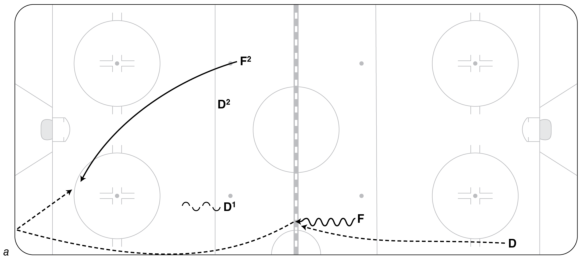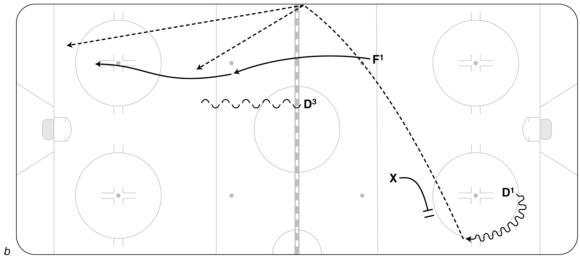Taking advantage of the hybrid icing rule
This is an excerpt from Hockey Plays and Strategies-2nd Edition by Mike Johnston,Ryan Walter.
With the recent hybrid icing rule being incorporated at the professional and many amateur levels, teams are now taking advantage of early area plays. Although these plays may go for icing, they usually create a foot race between the attacking forward and the defenseman. Coaches often allow or encourage one of the forwards to stretch early and then to use a flip pass, bank pass, or long direct pass to try to get in behind the opposition's defense (figure 3.2a). If the stretch player misses the pass, he must get to the face-off dot before the opposition defense so that the icing will be waived off. If the pass doesn't connect but the forward wins the foot race, possession will be obtained low in the offensive zone.

Figure 3.2a Taking advantage of the hybrid icing rule.
As mentioned in the chapter on breakouts, many teams now use indirect breakout passes to try to spring one of the wingers into open ice or get an odd-man rush. These passes are often made off the boards and into an area that the winger is skating toward. The player receiving the pass can often adjust his skating and get to the puck before the defensive team has a chance to adjust. Again, missing the pass is usually not a problem because of the hybrid icing rule and the advantage for the offensive team to win the race to the puck (figure 3.2b).

Figure 3.2b Bank pass to speed forward.
When playing five on five, the player with the puck must read the opponent's pressure when entering the offensive zone. If the gap between the player in possession of the puck and the defender is large or adequate, obviously the attacking player keeps possession of the puck and enters the attacking zone. If the player with the puck senses pressure, his first option is to pass, but if that isn't available, the cross-ice dump or chip are two tactics that can reduce this pressure and create a chance for puck possession deeper in the zone. Coaches should set up practice drills that incorporate this read. Drills that allow the puck carrier to react to varying gaps by the defender and varying pressure help to make these decisions with the puck more automatic and successful in game action.
SHOP

Get the latest insights with regular newsletters, plus periodic product information and special insider offers.
JOIN NOW


